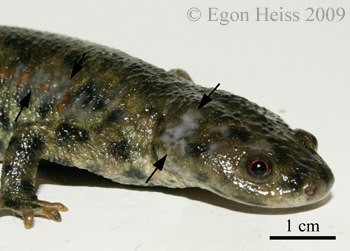Defense Mechanisms of the Spanish Ribbed Newt
By Stephanie Hoelker

P. waltl exposing its ribs in an arched position. Photo by permission, Egon Heiss.
Certain newts can attack a predator in a way that brings to mind the character Wolverine from X-Men. The Spanish ribbed newt, Pleurodeles waltl, gets its name from an unusual defense mechanism that allows the newt to actively force its ribs out through its back. The development of this anti-predatory action is not completely unique, as the Anderson's Crocodile Newt (Echinotriton andersoni) in a closely-related genus displays the same mechanism on a lesser scale. In a study published in 2009, Egon Heiss and colleagues observed and documented the anatomical adaptations that allow rib protrusion in the Spanish ribbed newt. This is a review article summarizing their findings.
Their study consisted of four parts, and each produced interesting results that added to or changed details that were previously known about this tactic. The first part of the experiment was a general observation and recording of the defensive behaviors. The newts did not resort to protruding their ribs immediately, as the first natural defense was to squirm and try to escape. As the second mode of defense, the newts secreted a slightly toxic discharge from the neck and the sides of the body. The toxin is merely irritating to humans, but can kill a mouse. Many species of newts produce secretions that make their skin slippery, distasteful, or sticky. The toxicity of some newts' skin secretions is well-documented (see Newt Toxin article).

Secretion of toxic mucous is another means of defense. Photo by permission, Egon Heiss.
The ribbed newt's last resort then becomes the rib protrusion defense. The observations showed that the newts could protrude their ribs with their body in either a flattened or arched position; the arched position is shown in the image. The ribs become slightly exposed, breaking the skin. Each rib protrudes out through the center of an orange bump, often referred to as a "wart" or "tubercle". These warts are present in two parallel lines running along the newts' backs, with eight to ten warts per row. The warts were freshly pierced open each time the newts exposed their ribs.
In the second part of the experiment, two newts had X-rays taken in both a relaxed state and in the defense posture. The images were used to measure the angles at which the ribs moved, using the end of the rib and the middle of the vertebra as reference points. In a relaxed position, the ends of the ribs were closer to the middle of the body, and the vertebral column had curvature. Upon stimulation, the ribs moved forward and outward, and the vertebral column straightened along the center axis of the animal. During this maneuver, the newt may or may not arch its back upward. Each individual responded differently, as each had a different stress limit, but each newt was consistent with itself among trials. In the past, it was thought that the ribs protruded due to bending of the body, but this study showed that the newt uses its back muscles to force the ribs out.

(a) An x-ray of the newt in a relaxed position. (b) An x-ray with the newt in its defensive stance. (c) An illustration demonstrating the angles of the ribs in relation to the center axis of the body in a relaxed position. (d) Another depiction of the angles when the animal is in the defensive stance. Photo by permission, Egon Heiss.
The last experiment was the examination of a histological specimen (a thin slice of the animal's tissue for viewing under a microscope). This experiment showed the rib actually protruding out of the body, proving that it punctures the skin. The end of the rib has a thick outer bone layer, which presumably helps it to puncture the skin, while the interior of the bone near the vertebra is fatty, probably an adaptation so that the bone doesn't fracture or break during protrusion. You may wonder why the newt is not hurt by its own toxin once the ribs penetrate the skin. The newt is actually immune to its own toxin, and in addition, it releases antimicrobials the help prevent infection after puncturing itself.
Reference
Heiss, E., N. Natchev, D. Salaberger, M. Gumpenberger, A. Rabanser & J.Weisgram (2009): Hurt yourself to hurt your enemy: new insights on the function of the bizarre antipredator mechanism in the salamandrid Pleurodeles waltl (Michahelles, 1830). Journal of Zoology (2009), 1-7. https://doi.org/10.1111/j.1469-7998.2009.00631.x.
© 2009 Stephanie Hoelker.
